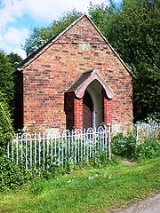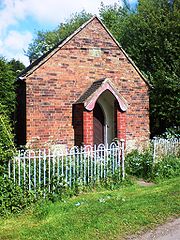
Coton Clanford
Encyclopedia
Coton Clanford is a small dispersed Staffordshire
village lying in gently rolling countryside 3 miles due west of Stafford
, England
and 1 mile southeast of Seighford
. The name of the village is sometimes hyphenated to Coton-Clanford, appearing this way on some cottage names locally. It lies midway between the B5405 road, 1½ miles to the north and the A518
1½ miles to the south. The village has no shops, public houses or church, comprising only a few scattered houses and cottages, several dairy farms and a long disused 19th century chapel.

 This Primitive Methodist chapel was built in 1884, the foundation stone being laid 30 October 1884. The Chapel records 1891–1907, Coton Clanford Society and Methodist chapel minute books, 1903-1929, are stored at Stafford
This Primitive Methodist chapel was built in 1884, the foundation stone being laid 30 October 1884. The Chapel records 1891–1907, Coton Clanford Society and Methodist chapel minute books, 1903-1929, are stored at Stafford
Record Office.http://www.staffordshire.gov.uk/NR/rdonlyres/01EB1EB7-BEBA-4B5C-8F52-AA6BD997FDA2/20997/Accessions2002.pdf Judging from the very modest dimensions of this small building it is hard to imagine it having the capacity for a congregation of more than 30 worshippers.
The village straddles Clanford Brook, which meanders southeastwards from Ranton
towards Little Aston and Doxey
and is bounded to the north by the southeastern edge of Seighford
airfield and several large woods.
In this village the English
philosopher and cleric, William Wollaston
, was born in 1659.
Staffordshire
Staffordshire is a landlocked county in the West Midlands region of England. For Eurostat purposes, the county is a NUTS 3 region and is one of four counties or unitary districts that comprise the "Shropshire and Staffordshire" NUTS 2 region. Part of the National Forest lies within its borders...
village lying in gently rolling countryside 3 miles due west of Stafford
Stafford
Stafford is the county town of Staffordshire, in the West Midlands region of England. It lies approximately north of Wolverhampton and south of Stoke-on-Trent, adjacent to the M6 motorway Junction 13 to Junction 14...
, England
England
England is a country that is part of the United Kingdom. It shares land borders with Scotland to the north and Wales to the west; the Irish Sea is to the north west, the Celtic Sea to the south west, with the North Sea to the east and the English Channel to the south separating it from continental...
and 1 mile southeast of Seighford
Seighford
Seighford is a small village about three miles west of Stafford in Staffordshire, England. The ford across a small stream is the origin of the village's name. The village has a red sandstone church, St...
. The name of the village is sometimes hyphenated to Coton-Clanford, appearing this way on some cottage names locally. It lies midway between the B5405 road, 1½ miles to the north and the A518
A518 road
The A518 is a road in the United Kingdom which runs from Uttoxeter, Staffordshire to Telford, Shropshire via Stafford and Newport. Between Uttoxeter and Stafford it is a single carriageway, with a staggered junction with the dual carriageway A51...
1½ miles to the south. The village has no shops, public houses or church, comprising only a few scattered houses and cottages, several dairy farms and a long disused 19th century chapel.


Stafford
Stafford is the county town of Staffordshire, in the West Midlands region of England. It lies approximately north of Wolverhampton and south of Stoke-on-Trent, adjacent to the M6 motorway Junction 13 to Junction 14...
Record Office.http://www.staffordshire.gov.uk/NR/rdonlyres/01EB1EB7-BEBA-4B5C-8F52-AA6BD997FDA2/20997/Accessions2002.pdf Judging from the very modest dimensions of this small building it is hard to imagine it having the capacity for a congregation of more than 30 worshippers.
The village straddles Clanford Brook, which meanders southeastwards from Ranton
Ranton, Staffordshire
Ranton is a small village in Staffordshire, situated west of Stafford, east of Woodseaves and northeast of Gnosall.-All Saints church, Ranton:All Saints church, Ranton, is a small ancient structure, dating from the 13th century....
towards Little Aston and Doxey
Doxey
Doxey is a village and civil parish in the borough of Stafford in Staffordshire, England. It is a north-western suburb of Stafford. The village became a civil parish on April 1, 2005....
and is bounded to the north by the southeastern edge of Seighford
Seighford
Seighford is a small village about three miles west of Stafford in Staffordshire, England. The ford across a small stream is the origin of the village's name. The village has a red sandstone church, St...
airfield and several large woods.
In this village the English
England
England is a country that is part of the United Kingdom. It shares land borders with Scotland to the north and Wales to the west; the Irish Sea is to the north west, the Celtic Sea to the south west, with the North Sea to the east and the English Channel to the south separating it from continental...
philosopher and cleric, William Wollaston
William Wollaston
William Wollaston was an English philosophical writer. He is remembered today for one book, which he completed only two years before his death: ....
, was born in 1659.

